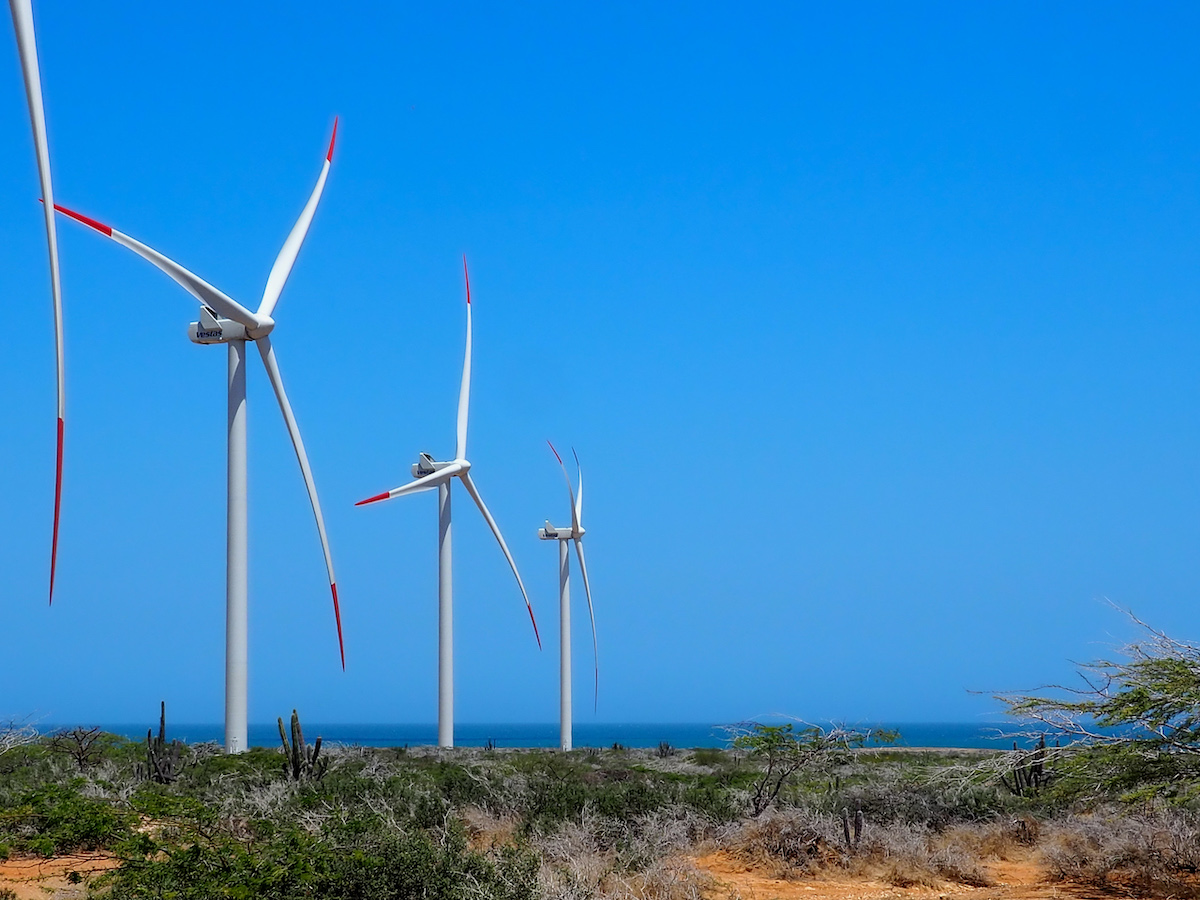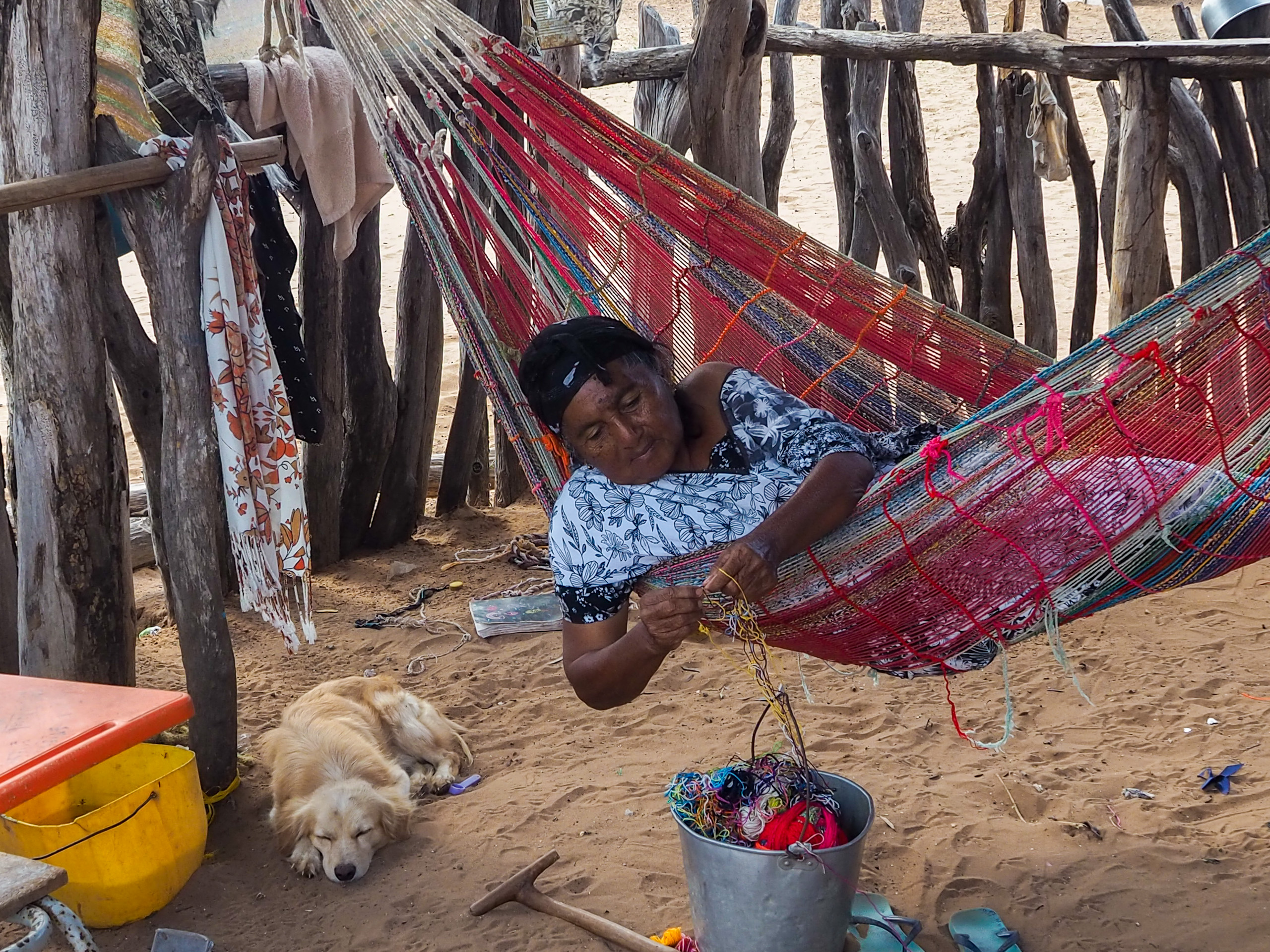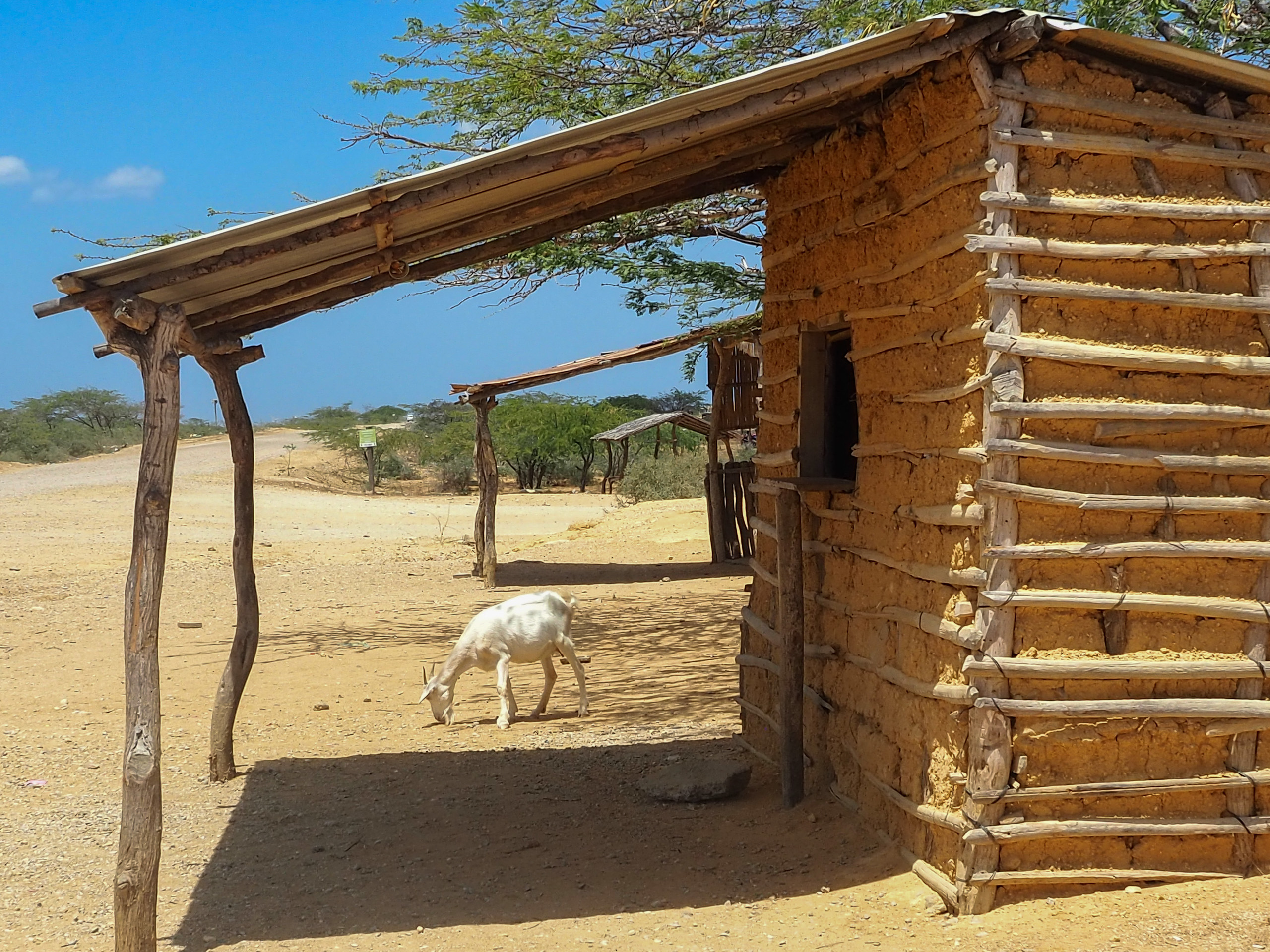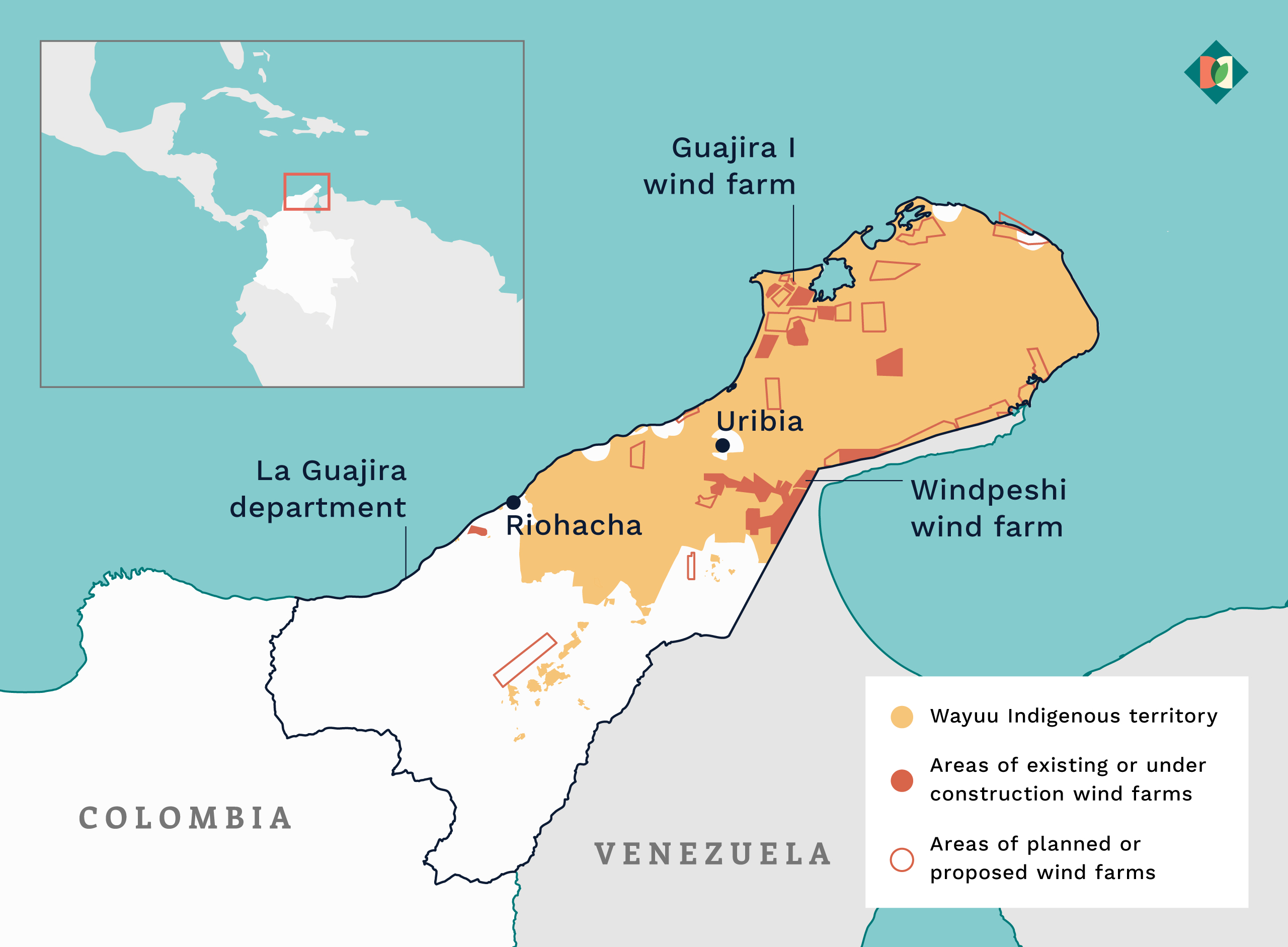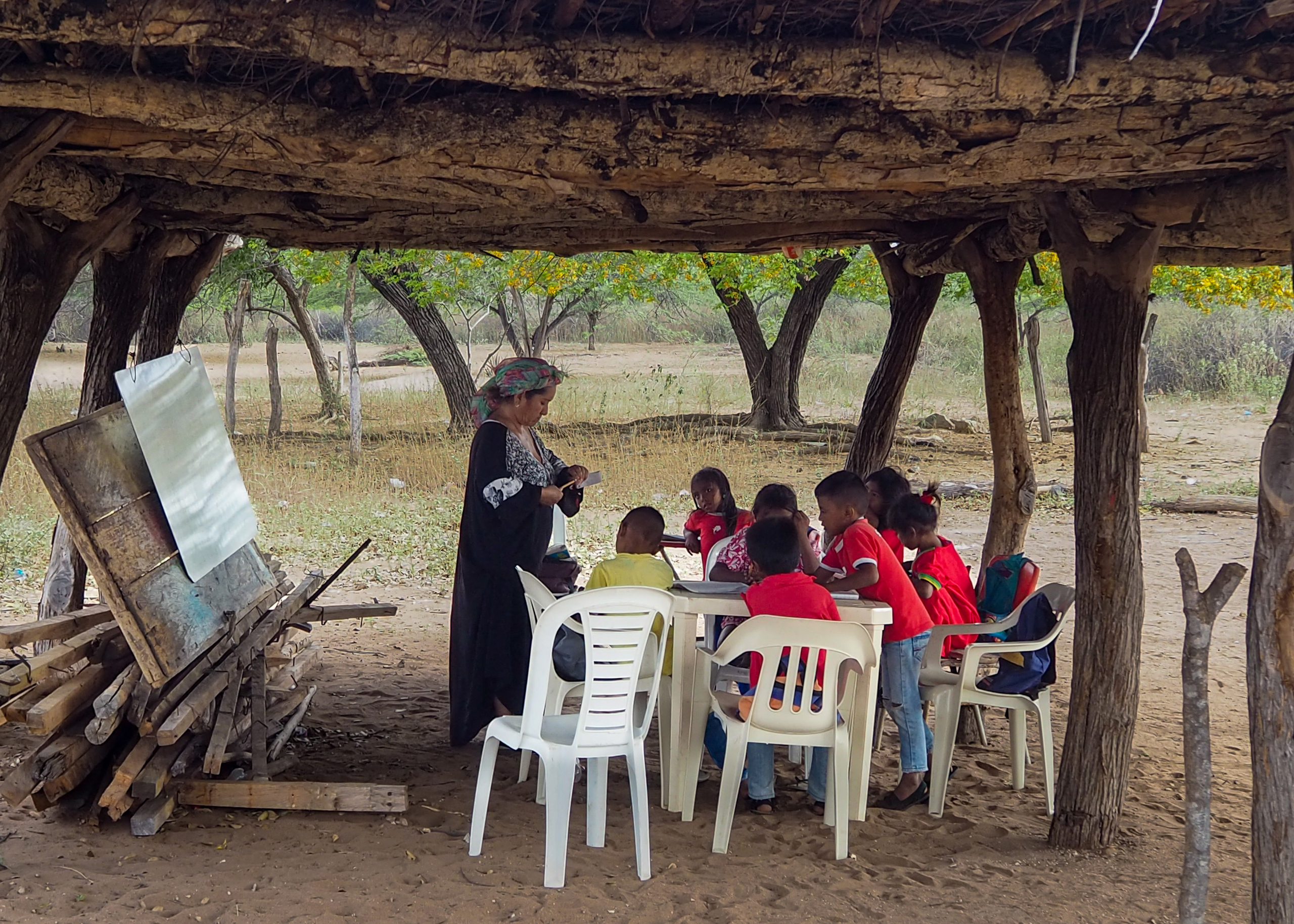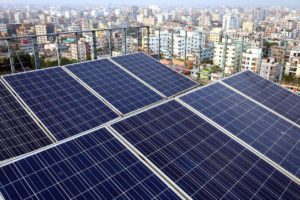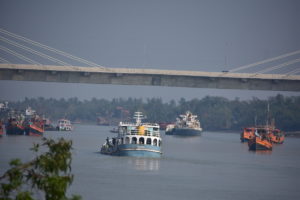We left early from Uribia, a municipality in northern Colombia that borders Venezuela. It is part of La Guajira department, a rugged territory covered by dry forest, buffeted by intense winds and with a year-round temperature of 30C.
I was travelling with Ismenia Iguarán, an environmentalist and Indigenous leader of the Wayuu people, on our way to meet other leaders who have raised opposition to wind power projects that are being built in La Guajira.
Iguarán is concerned. Not only because of social conflicts that have arisen in La Guajira since the arrival of these projects, but also because of the region’s high rates of poverty – the highest in the country, at 67% – and malnutrition that is mainly affecting children.
All along the almost deserted route, people from nearby communities blocked the roads with ropes to control the passage of visitors, the many checkpoints having seemingly become part of the landscape. Iguarán speaks with them in Wayuunaiki, the official language of the more than 287,000 Wayuu people in this part of Colombia. Not all visitors are welcome.
Tensions have arisen in La Guajira over national development plans and announcements by the government of President Gustavo Petro outlining aims to make the department the “epicentre” of the country’s energy transition.
Currently, there are 16 wind farms active or under construction across La Guajira, and more than 60 projects are planned or proposed to be built before 2030. But so far, the arrival of many of these facilities has spurred social tensions, particularly among Wayuu communities in the surrounding areas, with accusations of displacements, disagreements, extortion and even violence.
An initial silence
After two hours enduring the intense heat and numerous checkpoints, we finally neared the Guajira I wind farm. Built by Colombian energy company Isagen and operated by public utility provider EPM, the 20-megawatt facility is the largest such facility in the country.
It was 10 o’clock in the morning and the driver warned us to be back early. “In the afternoon,” he said, “the road is not safe for the arijuna,” using the Wayuu word for outsiders. He claimed there is a threat from armed assailants.
Upon arrival, we met with one of the Indigenous leaders, who preferred to remain anonymous. He told us that he had received compensation from Isagen, as Guajira I passed through his land. Although he had initially agreed to do the interview, he later refused to speak for fear of reprisals from his neighbours.

In the backyard of the neighbouring property stands a wind turbine more than 100 metres high, its long blades turning. The owner met us with suspicion. After speaking to Iguarán in Wayuunaiki, she did not wish to be interviewed either.
Our presence seemed to put the people on high alert. After a while, two vans arrived. Their Wayuu passengers told us we were allowed to take photographs for a little longer, but that “nobody is going to talk”.
Fractured projects
Exposed to coastal winds at Colombia’s northern tip, the wind power potential of the Guajira peninsula began to be exploited 20 years ago, when the region’s first wind farm, Jepirachi, was built by EPM. Now, as the government of Gustavo Petro aims to kickstart the country’s energy transition and accelerate clean energy projects, it has put special focus on this northern department.
Irene Vélez, the Minister of Mines and Energy, has made several trips to La Guajira in an effort to drive these objectives. During one visit, she said that the region could become “the green energy capital of the world”. The ministry’s Mining and Energy Planning Unit (UPME) has reportedly found that La Guajira has the potential for around 15 gigawatts of wind power capacity.
Martha Isabel Cobo, a researcher at the Ministry of Science, Technology and Innovation and dean of engineering at the University of La Sabana in Bogotá, told Diálogo Chino that Colombia currently has just 184 MW and 39.5 MW of solar and wind energy capacity, respectively, accounting for just 0.8% and 0.1% of the country’s energy mix.
She said the need to transition towards clean energy is urgent, and reported promising projections: “In the coming years, a growth in installed capacity is expected in both solar and wind technologies. By 2027, 16,650 MW of solar and 5,795 MW of wind are expected to be installed.”
But projects are not progressing at the expected pace, and gaps and inconsistencies in the consultation processes between energy companies and communities have in some cases led to serious conflicts. Some organisations have denounced wind farms as presenting “a new mode of extractivism” that could replicate the ills of the fossil fuel industry, creating disputes over land.
An official from the Ministry of the Interior, who asked not to be named, explained that there have also been surprising delays to wind projects in La Guajira. They said the region’s ongoing projects should by now be around 80% complete, but most have not even reached the 30% mark.
Across the department, wind farms have encountered problems with communities on nearby lands. Issues have varyingly arisen relating to displacement, compensation and consultation over projects, with disagreements on these issues, in some cases, leading to breakdown in relations and violence among Indigenous communities.
The interior ministry official said there is a need to find solutions through dialogue to improve implementation of projects, not only to help clean the country’s energy mix, but also to ensure benefits to Wayuu communities. The official highlighted a proposed measure in the new national development plan that would see an increase in the financial contribution renewable energy companies must make to nearby communities, from the current level of 1% of gross energy sales, to 6% – a contentious prospect in the energy industry.
The official said, however, that there had so far been no established institutional process for consultations over wind projects in La Guajira. Multiple cases of allegedly inadequate negotiations with Wayuu leaders in affected areas have been reported. “We could say that the consultation was invalid, flawed, and many times it was carried out outside the [relevant] territory, for some reason, as if to speed up the process,” the official added.
Despite these apparent flaws in previous processes, at the end of last year, speaking before more than 500 investors, Minister Vélez offered continuing incentives for energy projects, and said that it was “the right time to invest in Colombia”, claiming the country is implementing a “just” energy transition model.
Wayuu resistance
Wayuu leader José Silva welcomed us to his territory, an hour south of Uribia. Silva has spent years documenting the conflicts caused by extractive industries in La Guajira, which drove him to found the NGO Nación Wayuu. He described tensions and conflicts surrounding wind farms as growing increasingly acute.
“Today, in different territories, women have been murdered. Children, entire families, have been displaced,” he said, alleging that the arrival of the wind power projects and companies have driven these events.
Ismenia Iguarán, meanwhile, spoke of conflicts arising due to disagreements over compensation and benefits from energy companies for communities impacted by new projects. “The money coming from the wind projects is beginning to divide us,” she said.
The case of Leiji Hana González, a 32-year-old mother of two, is perhaps one of the more extreme. She has just settled in Riohacha, the capital of La Guajira, a seemingly paradisiacal city on the shores of the Caribbean. Despite the beauty of the place, she feels “in a prison”.
Earlier this year in her home village – which she asked not to be named for fear of reprisals – armed neighbours came to the house where her family had lived for 40 years. They shot and killed one of her aunts. After burying her that same day, González and her family escaped in the middle of the night, leaving with barely more than the clothes they were wearing.
According to González, villagers had received money as compensation for the proposed Windpeshi wind farm project to be carried out by Enel Colombia, the local subsidiary of the Italian energy multinational. She alleges that members of another Wayuu clan acquired weapons and sought to intimidate her family into leaving their land, in order to demand greater compensation from the company. She claims the perpetrators did this once her family had left the territory following her aunt’s murder.
“This community started buying weapons, they even threw two grenades at my house,” she said. “Before, the Wayuu didn’t have the money to buy weapons. Now they do.”
Some Wayuu, including González, have accused Enel, the company behind Windpeshi and five other renewable energy projects in Colombia, of stoking the violence and forcing displacements, accusations that company has denied.
After several years of disputes and controversies surrounding the Windpeshi farm, Enel Colombia announced on 24 May that it will suspend construction of the project indefinitely. In a statement, the company highlighted that over the past three years, the works had been halted at the site for roughly 50% of the time, due to protests and disruption.
Eugenio Calderón, manager for Colombia and Central America at Enel Green Power, said the suspension “hurts us as a company, but also as citizens committed to the energy transition”, and that the decision had been taken after “rigorous analyses and feasibility studies” concluded that it would be impossible for the works to proceed. Calderón added that Enel will “continue to engage with communities and stakeholders to address the implications of this decision.”
Possible solutions?
The president of Nación Wayuu, José Silva, argues that many of these impacts and disputes can be reduced with stronger processes and a well-managed consultation ahead of any project being launched. He cited as an example a community in the north of La Guajira that successfully negotiated with the Colombian energy company Celsia: the firm agreed to pay them 800 million pesos (US$ 177,000) in compensation for the installation of four wind turbines.
Silva said that this negotiation “had serious processes and prior consultation at all stages,” which ultimately allowed the community to gain the resources for the construction of an aqueduct, improve education and provide scholarships for young people.
Ismenia Iguarán is of another opinion. Although she is aware of the territory’s development needs, she said that anything that threatens the local environment should not be approved.
“We cannot continue to be invaded in such a violent way,” Iguarán said. “They are manipulating us and putting our culture at risk.”
